Form 8949, Sales and Other Dispositions of Capital Assets
Excise Tax Forms
Employment Tax Forms
Information Returns
Extension Forms
FinCEN BOIR
General
Introduction
Form 8949, Sales and Other Dispositions of Capital Assets is used to report sales, exchanges, or dispositions of capital assets, including stocks, bonds, and real estate. For tax-exempt organizations filing Form 990-T, 8949 attachment is used to report capital gains or losses arising from unrelated business income transactions.
In this guide, we'll learn more about Form 8949, providing insights into its purpose, filing requirements, and commonly asked questions.
Table of Contents
What is Form 8949?
Form 8949 reports the sale or exchange of capital assets, providing the IRS with details about each transaction. It lists information like the date of purchase, date of sale, cost basis, and proceeds, and classifies transactions as short-term (assets held for one year or less) or long-term (assets held for more than one year).
Who must file Form 8949?
Form 8949 must be filed by individuals, businesses, and tax-exempt organizations that have sold or exchanged capital assets during the tax year. This includes anyone who has received a Form 1099-B from a broker or anyone with a sale of assets such as stocks, bonds, real estate, or other investments
Choose TaxZerone - Your Gateway to Seamless Tax Filing
Complete your Form 990-T return and 8949 filing requirements with ease!
Choose TaxZerone to complete your Form 8949 filing.
Navigate the complexities of Form 8949 filing with TaxZerone, an IRS-authorized e-file service provider. Our intuitive platform and dedicated support team will guide you seamlessly through every step, ensuring a stress-free and efficient filing experience.
Here's how your Form 8949 attachment is transmitted to the IRS - just 3 simple steps!
- Provide Organization Details - Choose the tax year for which you want to file Form 8949 return, and provide your organization’s details.
- Preview Form 8949 - Attach Form 8949 to report sales and exchanges of capital assets and preview the information provided in the return for accuracy before transmitting.
- Transmit to the IRS - Transmit Form 8949 along with your 990-T Return to the IRS and get the acceptance in just a few hours.
With TaxZerone, you stay informed with instant updates on your return’s filing status, eliminating guesswork and anxiety. In addition, our excellent support team is always available to answer your questions and provide assistance throughout the filing process.
Even if the IRS rejects your return, our platform allows you to make necessary corrections and resubmit it for FREE!
Embrace the Future of Tax Filing – Choose TaxZerone Today!
Make your e-filing process simple by clicking the button below.
Start E-filing NowCommonly Asked Questions
1. How do I know if I need to file Form 8949?
2. What is the difference between short-term and long-term transactions on Form 8949?
Short-term transactions involve assets held for one year or less, while long-term transactions involve assets held for more than one year. These are reported separately on Form 8949 because they are subject to different tax rates.




